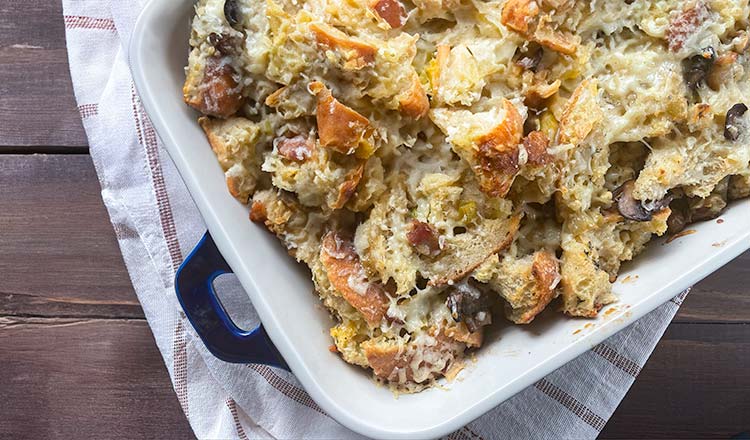One of the most surprisingly underrated foods is the strata. Made from bread, eggs, milk, and fillings, a strata is a cross between a savory bread pudding and a stuffing (or dressing). It’s an appropriate dish for any meal of the day, endlessly customizable, filling, simple to prepare, and best yet—doesn’t even require a recipe.
Fillings for stratas often include aromatics (like shallot or leek), veggies, and sometimes a meat. Because they are most commonly served at brunch, the ingredients are typically similar to those you might see in a quiche or frittata: sausage, ham, cheese, greens, peppers. But that shouldn’t stop you from trying your favorites (or, what you have in the fridge).
To prepare a strata:
- Prepare your fillings. Meats should be cooked before adding to your mixture and most vegetables benefit from a pre-cook. Stratas don’t take long to cook, so pre-cooking will ensure they’re ready at the same time as the other ingredients, and your finished dish won’t be bogged down by lots of moisture from the vegetables. But you also gain a lot of flavor from roasting or sautéing your ingredients for some caramelization, especially if you include fresh herbs or spices. For a 9-in by 13-in baking dish, you’ll want at least three to four cups of finished filling ingredients. If you’re using meat, about 1 lb will be enough.
Some great combinations include:
-
- Italian sausage, kale, mushroom, shallot, and fontina cheese
- Chorizo, sweet potato, red onion, pickled jalapeño, and pepper Jack cheese
- Ham, leek, asparagus, and Gruyère
- Sundried tomato, spinach, basil, mozzarella, and Parmigiano-Reggiano
- Broccoli, shallot, and Cheddar
- Cube a loaf of bread. The size depends on your preference, but about 3/4-inch squares are soak up the egg mixture without getting mushy. Avoid very soft breads, like brioche, challah, or white breads, which might become too soft after cooking. Instead, we like crusty breads, like sourdoughs, multigrain, or a classic French bread. You’ll want about 10 cups of cubed bread, which is an average round of sourdough. If you don’t have quite that much, it’s okay. Your strata will just be a touch more custardy.
- Make your custard by whisking together eggs and a dairy or non-dairy substitute, like milk, half and half, or oat milk. Season your custard with salt and pepper, plus anything else that goes well with your ingredients. A dollop of Dijon mustard is common, but you can add anything from prepared pesto to your favorite hot sauce. For the same 9-in by 13-in baking dish, you’ll want to use about 6 eggs and 1 1/2 cups liquid, but you can experiment to find the texture you like best. Extra egg yolks will make the mixture creamy and rich, while extra milk will make the finished strata softer and more bread pudding-like.
- Pick a cheese, if you’d like. Choose one or more cheeses that melt well and compliment your fillings, like Cheddar, Gruyère, or fontina; shred the cheeses. You can add flavorful hard cheeses, like grated Pecorino, if you like. Prepare about 2 cups shredded cheese for a 9-in by 13-in pan.
- Assemble your strata. Layering the ingredients ensures an even distribution, so start by spreading half of your bread at the bottom of a greased 9-in by 3-in pan. Top the bread with half of your fillings, then half of your cheese. Repeat with the remaining ingredients. Pour the custard mixture evenly over the other ingredients. If the top of the strata looks very dry, prepare another small batch of custard, using 2 eggs for every 1/4 cup liquid. The bread should not be soaked and soggy, but you should be able to see the liquid being absorbed near the top of the strata.
- Rest your strata, preferably overnight. Tightly cover your baking dish and refrigerate for as long as possible, up to 24 hours and at least 3 hours. It’s essential to give time for the bread to absorb the liquids, or else your strata will be dry bread surrounded by egg.
- Bake the strata. If using a glass baking dish, you should take your strata out of the oven to come to room temperature, at least one hour. Preheat the oven to 350°F and bake, uncovered, until the custard is set and the cheese is melted, about 35 minutes. Serve the strata hot or at room temperature.


